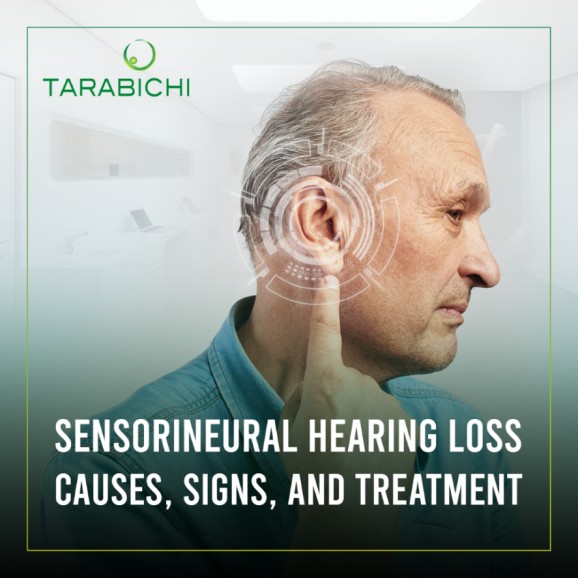Sensorineural Hearing Loss: Causes, Signs, and Treatment
Contact Us
Sensorineural hearing loss is a prevalent auditory condition that affects a significant number of individuals worldwide. If you're experiencing hearing difficulties or simply seeking to broaden your knowledge, this article aims to provide comprehensive insights into sensorineural hearing loss, including its causes, symptoms, and available treatment options.
What is sensorineural hearing loss?
- Sensorineural hearing loss, also known as SNHL, is a type of hearing impairment that results from harm or dysfunction to the inner ear (cochlea) or the auditory nerve route that connects the ear to the brain. It is the most common form of permanent hearing loss and can affect individuals of all ages, from newborns to the elderly.
- The inner ear plays a vital role in converting sound vibrations into electrical signals that can be understood by the brain. Sensorineural hearing loss occurs when there is damage to the delicate hair cells within the cochlea or a disruption in the transmission of these electrical signals through the auditory nerve.
Causes of sensorineural hearing loss:
⦁ Age related factors.
⦁ Prolonged exposure to loud noises.
⦁ Genetic factors (even at a young age).
⦁ Infections such as meningitis, mumps or measles.
⦁ Ototoxic medications.
⦁ Diabetes.
⦁ Meniere's disease.
⦁ Head injury.
Symptoms of sensorineural hearing loss:
There are many symptoms and signs that may indicate that you have this condition, the most prominent of which are:
⦁ Difficulty understanding speech, especially in noisy environments.
⦁ Muffled or distorted hearing.
⦁ Reduced ability to hear soft sounds.
⦁ Tinnitus, which is the perception of ringing, buzzing, or other phantom sounds in the ears.
⦁ Difficulty localizing sounds.
Sensorineural hearing loss diagnosis:
You cannot diagnose this condition on your own, but you must consult an ENT specialist or audiologist. Your diagnosis is usually carried out through the following procedures:
1- Medical history and examination:
- The healthcare professional will inquire about your medical history, including any known risk factors or exposure to loud noises. They will also perform a physical examination to rule out any underlying medical conditions contributing to hearing loss.
2- Hearing tests:
- Audiometric tests are conducted to evaluate hearing sensitivity and determine the type and degree of hearing loss. These tests may include pure-tone audiometry, speech audiometry, and tympanometry.
3- Speech understanding assessment:
- This test measures an individual's ability to understand speech at different volumes and in various listening conditions.
It's important to mention that in some cases, tests such as otoacoustic emissions (OAE) or auditory brainstem response (ABR) may be conducted to assess the functionality of the inner ear and auditory nerve pathways.
Also read:
- Banishing Cholesteatoma: Effective Strategies for Treatment.
- The Mystery of Hoarseness: Causes, Symptoms, and Solutions.
Sensorineural hearing loss treatment
Like all medical conditions, treatment depends on the circumstances of the individual case and the depth of the injury. However, the most popular treatments are:
1- Hearing aids:
- Hearing aids are the most common and effective treatment for sensorineural hearing loss. Modern hearing aids come in various styles and technologies, including behind-the-ear (BTE), in-the-ear (ITE), and completely-in-the-canal (CIC) options.
2- Cochlear implants:
- Cochlear implants bypass the damaged parts of the inner ear and directly stimulate the auditory nerve, allowing individuals to perceive sound.
Read more about Cochlear Implants here.
3- Assistive Listening Devices (ALDs):
ALDs are devices that enhance sound transmission in specific listening situations. They can be used in conjunction with hearing aids or as standalone devices.
What is the difference between sensorineural hearing loss and hearing loss?
Sensorineural hearing loss is one specific type of hearing loss, distinguished by its underlying cause and location of damage within the auditory system. On the other hand, hearing loss can be broadly categorized into three main types:
1- Sensorineural Hearing Loss:
- This is the type we discussed in our previous article. It occurs when there is damage or dysfunction in the inner ear (cochlea) or the auditory nerve pathway that connects the ear to the brain.
2- Conductive Hearing Loss:
This type of hearing loss occurs when there is a problem in the outer or middle ear that hinders sound conduction to the inner ear. It can be caused by factors such as earwax buildup, ear infections, fluid in the middle ear, or problems with the ear bones (ossicles).
3- Mixed Hearing Loss:
This is a combination of sensorineural and conductive hearing loss. It means that there is damage or dysfunction in both the inner ear and the outer or middle ear.
It's important to note that while sensorineural hearing loss is a specific type of hearing loss, the term "hearing loss" can be used as a general term to encompass all types of hearing impairments.
You can also view:
If you are looking for the Best ENT Doctor in Dubai or the Best ENT Specialist in Dubai, please reach out to us on the below details, our team comprises of only the best ent doctors in UAE and the region.




